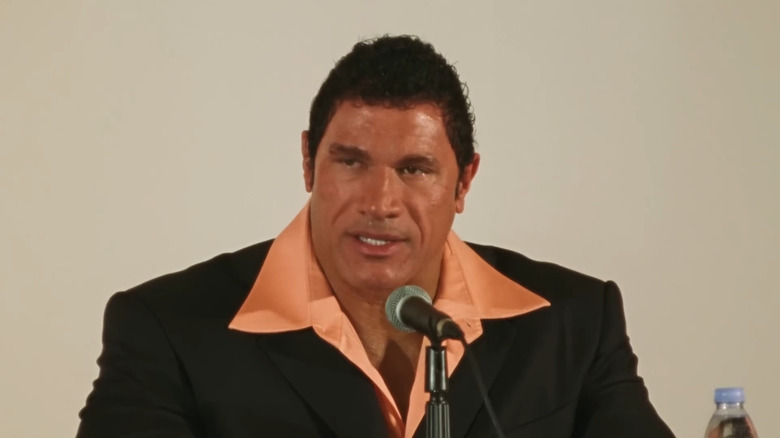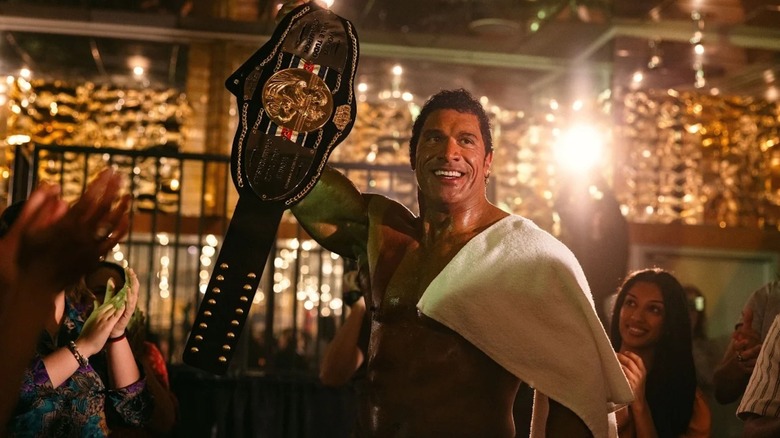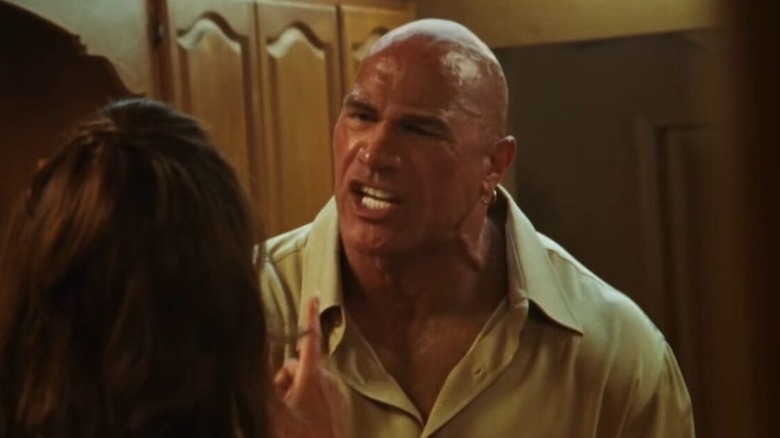How The Smashing Machine Compares To The Real-Life Story Of Mark Kerr
Benny Safdie's "The Smashing Machine" covers four years in the tumultuous life of former MMA powerhouse Mark Kerr (played brilliantly by Dwayne Johnson). He earned this nickname for his trademark ground-and-pound style of fighting. When Kerr got you on your back, there was an excellent chance he was going to turn your face into hamburger if you didn't tap out. In his prime, he was a bit like Mike Tyson; your primary goal was to simply survive the fight.
Safdie could've easily taken a boilerplate biopic approach to Kerr's life, documenting his early triumphs (winning the Ohio state wrestling championship while attending Toledo Waite, and besting Randy Couture for the men's Division 1 wrestling championship), and digging deeper into the volatile relationship between the athlete and his alcoholic wife Dawn Staples (Emily Blunt), but in tightening his narrative focus he amplifies Kerr's passion for the sport and the immediacy of the task at hand. In his late 20s and early 30s, Kerr was in his fighting prime. He wanted to be the best MMA fighter in the world.
Safdie used Kerr as an advisor, and opened himself up to the subject of his film in order to gain his full trust. Safdie was determined to do justice to this vital stretch of Kerr's life. Does this mean everything you see in the film happened exactly as depicted? Not exactly. Interestingly, it's not so much the dramatic licenses that hurt the movie, but what it leaves out that leaves it feeling dramatically inert.
Kerr really was a gentle bruiser
Dwayne Johnson's portrayal of Kerr hits all of the right notes — to the extent that the viewer knows his persona from interviews and the very good HBO documentary "The Smashing Machine: The Life and Times of Extreme Fighter Mark Kerr." He really was a friendly, soft-spoken, shockingly polite dude who viewed himself as an ambassador for a controversial sport. Alas, this is one area where Safdie's movie comes up short. While I'm sure Kerr's amiableness wasn't a PR charm offensive, he loved this hybrid form of fighting; if they'd put him in front of a Congressional committee chaired by John McCain (who loathed the sport and called it "human cockfighting"), I have every confidence he could've delivered a sincere, Fred Rogers-esque defense of MMA (who, along with securing vital PBS funding back in the day, also helped launch the career of George A. Romero).
In any event, Kerr's most important fights were held in Japan for a reason, and the tragedy of his career is that he couldn't hang on long enough to be competitive in the ring (or octagon) when the UFC became bigger than boxing. Then again, that's a different movie than Safdie apparently wanted to make. He wanted a melancholy character study of a man who couldn't stay out of his own way long enough to reach the height of a then disreputable sport.
As for the real-life details, there were several alterations, all of which Safdie made to lend the film a little more personality and/or emotional impact.
Safdie only took dramatic license when necessary
In a video chat with USA Today, Kerr makes it clear that Safdie was determined to capture the spirit of Kerr's life between 1997 and 2000. He was also committed to showing audiences just how vulnerable this pulverizer of human flesh could be outside of the ring, which, according to Safdie, occasionally required "putting people in rooms they weren't, making things up and trying to glean things about what happened."
That amusing scene where Kerr refuses to join Staples on a Rotor ride at a carnival (like the one Antoine Doinel boards in "The 400 Blows"), which then cuts to a shot of him having the time of his life on an old-fashioned carousel refers to "something similar" that occurred between Kerr and Staples. Kerr freely acknowledges that a merry-go-round is more his speed. And what about that delicate tummy Kerr complains about in that scene? Kerr told Safdie's he's not in the habit of using the word "tummy," but he was okay with this minor change — which is good because a musclebound guy fretting over his "tummy" is undeniably hilarious.
One interesting departure from real life involves the smashing of a pricey Japanese vase that Kerr bought for Staples. As she whips herself up into a rage (because Kerr has been emotionally withholding, and she's drinking her way through her sadness), she shatters the valuable object to explicitly hurt him. In reality, it was a silk Japanese robe that got slashed up, but Safdie was correct in thinking that Blunt going all Esther Rolle on a vase was a more visually distressing gesture. Later in the film, an inebriated Staples finds Kerr's Glock (which had no safety) and points it at her head. This happened, and, as is depicted in the film, Kerr believes this disastrously failed reunion with Staples, which broke up his training prior to his pivotal fight with Kazuyuki Fujita at the 2000 Pride Grand Prix Finals, played a psychological role in his devastating loss.
As for Kerr's opioid addiction, he was evidently sober after in the immediate wake of his 1999 overdose, but he did slip. According to Kerr, he's now been sober for seven years. And, yes, that is the real Kerr you see cheerily grocery shopping at the end of the movie.
"The Smashing Machine" is now in theaters.


